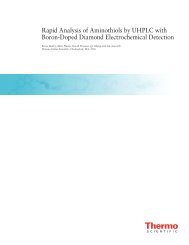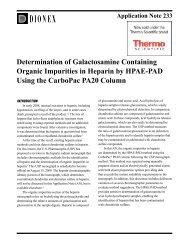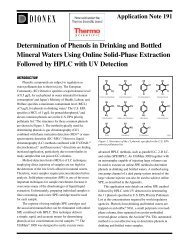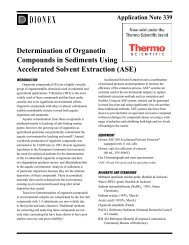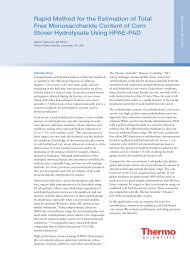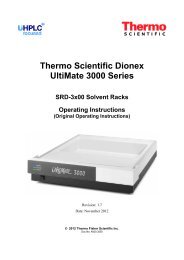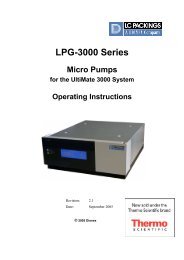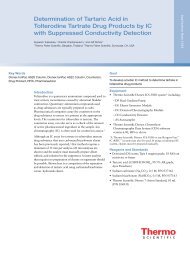Determination of Dioctylsulfosuccinate (DOSS) in Oysters ... - Dionex
Determination of Dioctylsulfosuccinate (DOSS) in Oysters ... - Dionex
Determination of Dioctylsulfosuccinate (DOSS) in Oysters ... - Dionex
Create successful ePaper yourself
Turn your PDF publications into a flip-book with our unique Google optimized e-Paper software.
<strong>Determ<strong>in</strong>ation</strong> <strong>of</strong> <strong>Dioctylsulfosucc<strong>in</strong>ate</strong><br />
(<strong>DOSS</strong>) <strong>in</strong> <strong>Oysters</strong> Us<strong>in</strong>g S<strong>in</strong>gle Quadrupole<br />
Mass Spectrometry<br />
Jonathan R. Beck, 1 Marcus Miller, 2 Leo J<strong>in</strong>yuan Wang, 2 and William C. Schnute, 2<br />
1<br />
Thermo Fisher Scientific, San Jose, CA; 2 Thermo Fisher Scientific, Sunnyvale, CA, USA
Overview<br />
A simplified method for extraction <strong>of</strong> sodium dioctylsulfosucc<strong>in</strong>ate (<strong>DOSS</strong>) from oysters<br />
is demonstrated <strong>in</strong> this work. Previous methods employed extraction protocols based on<br />
QuEChERS methods. 1 Here, a Thermo Scientific <strong>Dionex</strong> ASE 350 Accelerated Solvent<br />
Extractor allowed s<strong>in</strong>gle-step extraction us<strong>in</strong>g a mixture <strong>of</strong> water and acetonitrile to achieve<br />
high extraction effi ciencies. The extract was filtered and then diluted to a fi nal concentration<br />
with<strong>in</strong> the valid calibration range established. Use <strong>of</strong> standards <strong>in</strong> deionized water<br />
demonstrated l<strong>in</strong>ear response across three orders <strong>of</strong> magnitude and provided the basis for<br />
determ<strong>in</strong>ation <strong>of</strong> <strong>DOSS</strong> concentrations <strong>in</strong> oyster extracts and salt water samples. In addition to<br />
l<strong>in</strong>ear response, high recoveries and low carryover were demonstrated. The Thermo Scientifi c<br />
MSQ Plus Mass Detector (s<strong>in</strong>gle quadrupole) provided the sensitivity and selectivity when<br />
coupled with HPLC chromatography. The complete extraction and analysis proved to be<br />
rugged, and it was possible to identify the target analyte even at very low concentrations and <strong>in</strong><br />
complex biological matrices.<br />
Introduction<br />
Dur<strong>in</strong>g the Deepwater Horizon disaster, over 1.8 million gallons <strong>of</strong> dispersants were used<br />
<strong>in</strong> the Gulf <strong>of</strong> Mexico. 2 The primary dispersant used was COREXIT ® 9500 (Nalco Co.,<br />
Naperville, IL) along with small amounts <strong>of</strong> COREXIT 9527. Both these proprietary mixtures<br />
conta<strong>in</strong> <strong>DOSS</strong> as the major component. 3 <strong>DOSS</strong> has low volatility and a potential to persist<br />
<strong>in</strong> the environment, and there is concern that COREXIT component substances have a<br />
potential to bioconcentrate. 4 Analysis for <strong>DOSS</strong> serves as a useful marker to assess the<br />
presence and persistence <strong>of</strong> these dispersants. This study was undertaken to identify a rapid<br />
extraction technique and subsequent analysis that would allow for the identifi cation and<br />
quantitation <strong>of</strong> <strong>DOSS</strong>.<br />
Methods<br />
Instrumentation<br />
Extraction<br />
<strong>Dionex</strong> ASE 350<br />
Chromatography<br />
Thermo Scientifi c <strong>Dionex</strong> UltiMate 3000 LC<br />
LPG-3000 Series Low-Gradient Pump<br />
FLM-3100 Flow Manager<br />
WPS-3000 Autosampler<br />
MSQ Plus Mass Detector (s<strong>in</strong>gle quadrupole)<br />
AXP-MS Auxiliary Pump<br />
Thermo Scientifi c <strong>Dionex</strong> Chromeleon 6.8 SR10 Chromatography Data System s<strong>of</strong>tware<br />
Chromatographic Condit<br />
(3 µm, 120 A, 2.1 mm ×<br />
Mobile Phase: Solvent A = Water + 0.1<br />
Solvent B = Acetonitrile<br />
HPLC System<br />
Column: Thermo Scientifi c Accla<br />
Gradient Time (m<strong>in</strong>) % B<br />
0 45<br />
3 45<br />
6 95<br />
9 95<br />
9.01 45<br />
12 45<br />
Flow Rate: 0.45 mL/m<strong>in</strong><br />
Inj. Volume: 25 µL (full loop)<br />
Temperature: 40 °C<br />
Mass Spectrometer Parameters for<br />
ESI, negative ion<br />
SIM scan, 421.1 m/z with 0.7 m/z span<br />
N 2<br />
pressure: 80 psi<br />
Probe Temperature: 400 °C<br />
Needle Voltage: 2 kV<br />
Cone Voltage: 70 V<br />
A divert valve was plumbed after the co<br />
compounds to be directed away from th<br />
analyte <strong>of</strong> <strong>in</strong>terest. A flow rate <strong>of</strong> 0.1 mL<br />
low-volume mix<strong>in</strong>g tee prior to the mas<br />
the mass spectrometer dur<strong>in</strong>g eluent d<br />
dry out.<br />
Divert Valve:<br />
Time (m<strong>in</strong>) Position<br />
0 To Waste<br />
3.0 To Mass<br />
6.5 To Waste<br />
FIGURE 1. Schematic <strong>of</strong> the HPLC-m<br />
Extraction Conditions<br />
The oyster emulsion (prepared as described <strong>in</strong> Chemicals and Reagents section) was<br />
ma<strong>in</strong>ta<strong>in</strong>ed at 4 °C until just prior to extraction. To prepare the extraction vessels, a clean glass<br />
fiber filter (P/N: 068092) was placed on the bottom <strong>of</strong> the 10 mL sta<strong>in</strong>less steel extraction<br />
vessel and the bottom cap was screwed <strong>in</strong> place. The extraction vessel was then loaded with<br />
1g <strong>of</strong> diatomaceous earth (ASE prep DE−CAS 68855-54-9, P/N: 062819) that was ground<br />
with a mortar and pestle. A 1 mL aliquot <strong>of</strong> oyster emulsion was loaded on top <strong>of</strong> the DE. The<br />
rema<strong>in</strong><strong>in</strong>g space <strong>in</strong> the extraction vessel was fi lled with DE, a second glass fi ber filter was<br />
placed on the top <strong>of</strong> the vessel, and the top cap was screwed <strong>in</strong> place. For spiked samples, an<br />
aliquot <strong>of</strong> <strong>DOSS</strong> was added directly to the oyster emulsion prior to fi ll<strong>in</strong>g the cell with DE.<br />
A<br />
B<br />
Ultimate 3000 Pump 1<br />
450 µL/m<strong>in</strong><br />
Si<br />
The extraction vessels were loaded <strong>in</strong> the top carousel <strong>of</strong> the ASE 350 <strong>in</strong>strument, and 60 mL<br />
glass collection vials were weighed then placed <strong>in</strong> the bottom carousel. The extraction mode<br />
used was standard, with an oven temperature <strong>of</strong> 100 °C, extraction pressure <strong>of</strong> 1000 psi, and<br />
a static cycle time <strong>of</strong> 5 m<strong>in</strong>utes for a s<strong>in</strong>gle cycle followed by a r<strong>in</strong>se volume <strong>of</strong> 60% and a gas<br />
purge <strong>of</strong> the vessel for 90 seconds. The extraction solvent used was 1:1 acetonitrile/water.<br />
Between samples, a 5 mL r<strong>in</strong>se <strong>of</strong> <strong>of</strong> solvent was used to m<strong>in</strong>imize carry-over.<br />
Follow<strong>in</strong>g extraction, the collection vessels were weighed and the difference from tared weight<br />
noted for use <strong>in</strong> calculat<strong>in</strong>g the concentration factor for each sample analyzed.<br />
Data System<br />
Chemicals and Reagents:<br />
<strong>DOSS</strong> was purchased from Sigma-Ald<br />
structure is shown below.<br />
FIGURE 2. Chemical structure for DO<br />
LPN 2 3019<br />
<strong>Determ<strong>in</strong>ation</strong> <strong>of</strong> <strong>Dioctylsulfosucc<strong>in</strong>ate</strong> (<strong>DOSS</strong>) <strong>in</strong> <strong>Oysters</strong> Us<strong>in</strong>g S<strong>in</strong>gle Quadrupole Mass Spectrometry
SS) from oysters<br />
protocols based on<br />
ccelerated Solvent<br />
acetonitrile to achieve<br />
o a fi nal concentration<br />
onized water<br />
provided the basis for<br />
er samples. In addition to<br />
d. The Thermo Scientifi c<br />
y and selectivity when<br />
alysis proved to be<br />
low concentrations and <strong>in</strong><br />
ispersants were used<br />
9500 (Nalco Co.,<br />
ese proprietary mixtures<br />
d a potential to persist<br />
substances have a<br />
arker to assess the<br />
ertaken to identify a rapid<br />
he identifi cation and<br />
ata System s<strong>of</strong>tware<br />
nts section) was<br />
ion vessels, a clean glass<br />
less steel extraction<br />
el was then loaded with<br />
819) that was ground<br />
d on top <strong>of</strong> the DE. The<br />
glass fi ber filter was<br />
. For spiked samples, an<br />
<strong>in</strong>g the cell with DE.<br />
0 <strong>in</strong>strument, and 60 mL<br />
l. The extraction mode<br />
ressure <strong>of</strong> 1000 psi, and<br />
olume <strong>of</strong> 60% and a gas<br />
1:1 acetonitrile/water.<br />
rry-over.<br />
erence from tared weight<br />
nalyzed.<br />
Chromatographic Conditions<br />
HPLC System<br />
Column: Thermo Scientifi c Acclaim 120 C18 column<br />
(3 µm, 120 A, 2.1 mm × 150 mm)<br />
Mobile Phase: Solvent A = Water + 0.1% Formic Acid<br />
Solvent B = Acetonitrile + 0.1% Formic Acid<br />
Gradient Time (m<strong>in</strong>) % B<br />
0 45<br />
3 45<br />
6 95<br />
9 95<br />
9.01 45<br />
12 45<br />
Flow Rate: 0.45 mL/m<strong>in</strong><br />
Inj. Volume: 25 µL (full loop)<br />
Temperature: 40 °C<br />
Mass Spectrometer Parameters for <strong>DOSS</strong>:<br />
ESI, negative ion<br />
SIM scan, 421.1 m/z with 0.7 m/z span, dwell time: 0.8 second<br />
N 2<br />
pressure: 80 psi<br />
Probe Temperature: 400 °C<br />
Needle Voltage: 2 kV<br />
Cone Voltage: 70 V<br />
A divert valve was plumbed after the column to allow the eluent and other background<br />
compounds to be directed away from the mass spectrometer before and after the elution <strong>of</strong> the<br />
analyte <strong>of</strong> <strong>in</strong>terest. A flow rate <strong>of</strong> 0.1 mL/m<strong>in</strong> <strong>of</strong> 1:1 water and acetonitrile was added us<strong>in</strong>g a<br />
low-volume mix<strong>in</strong>g tee prior to the mass spectrometer. This provided a steady stream <strong>of</strong> fl uid to<br />
the mass spectrometer dur<strong>in</strong>g eluent diversion to ensure the needle and spray <strong>in</strong>terface did not<br />
dry out.<br />
Divert Valve:<br />
Time (m<strong>in</strong>) Position<br />
0 To Waste<br />
3.0 To Mass Spectrometer<br />
6.5 To Waste<br />
FIGURE 1. Schematic <strong>of</strong> the HPLC-mass spectrometer system used here.<br />
A<br />
B<br />
Ultimate 3000 Pump 1<br />
450 µL/m<strong>in</strong><br />
Data System<br />
Signal<br />
Chemicals and Reagents:<br />
<strong>DOSS</strong> was purchased from Sigma-Aldrich (CAS 577-11-7, Aldrich: 323586). The chemical<br />
structure is shown below.<br />
FIGURE 2. Chemical structure for <strong>DOSS</strong>.<br />
HPLC Column<br />
MSQ Plus<br />
Divert Valve<br />
Waste<br />
Acetonitrile<br />
Micro Tee<br />
AXP Pump<br />
1:1 Acetonitrile/water<br />
27788<br />
Acetonitrile was obta<strong>in</strong>ed from Burdick<br />
water was produced by a Millipore wa<br />
was obta<strong>in</strong>ed from Fluka (CAS 64-18-<br />
salt (Instant Ocean Sea Salt, Spectrum<br />
recommendations. A solution <strong>of</strong> appro<br />
prepared by dissolv<strong>in</strong>g 30 g aquarium<br />
A primary stock solution <strong>of</strong> <strong>DOSS</strong> was<br />
stock solutions were prepared by dilut<br />
<strong>in</strong>to 50 ppm and 500 ppb concentratio<br />
calibration standards.<br />
<strong>Oysters</strong> were obta<strong>in</strong>ed from a local ma<br />
Willapa Bay, Wash<strong>in</strong>gton). A food blend<br />
us<strong>in</strong>g one 8 oz package <strong>of</strong> oysters and<br />
emulsion was stored at 4 °C and the bo<br />
sampl<strong>in</strong>g. Syr<strong>in</strong>ge filters (IC tAcrodisc ®<br />
PALL Scientific P/N 4583T) were used t<br />
Results<br />
Calibration<br />
<strong>DOSS</strong> standards were prepared <strong>in</strong> DI w<br />
500 ppb and 1, 2, and 5 ppm. Full loop<br />
125 ng loaded on column (Figure 3). Sa<br />
100, 200, 500 and 1000 ppb. These sam<br />
(CH 3<br />
CN + 0.1% formic acid) to improve<br />
FIGURE 3. Calibration for <strong>DOSS</strong> <strong>in</strong> D<br />
55,000<br />
<strong>DOSS</strong> counts<br />
LOD = 4.6 ppb<br />
Based on 7 replicate<br />
0<br />
0.0 0.5 1.0 1.5 2<br />
Oyster Samples<br />
Oyster emulsion was spiked with DOS<br />
analyzed as unspiked blanks. Three s<br />
Collection vials were weighed before a<br />
All extractions were fi ltered us<strong>in</strong>g a sy<br />
acetonitrile and water. This prepared s<br />
at 5 o C to await analysis.<br />
Chromatography<br />
As shown <strong>in</strong> Figure 4, <strong>DOSS</strong> was well<br />
acidifi ed solvents to keep the analyte i<br />
organic solvent concentration (45%) a<br />
be washed <strong>of</strong>f the column and diverted<br />
concentration followed that reduced th<br />
and ended at a high organic concentra<br />
the column. This improved method rug<br />
content, or oyster extractions which ar<br />
O<br />
O<br />
O<br />
Na + - O<br />
S<br />
O<br />
O<br />
O<br />
28650<br />
Thermo Scientific Poster Note • LPN3019-01_e 11/11SV<br />
3
ther background<br />
nd after the elution <strong>of</strong> the<br />
rile was added us<strong>in</strong>g a<br />
steady stream <strong>of</strong> fl uid to<br />
nd spray <strong>in</strong>terface did not<br />
ed here.<br />
Divert Valve<br />
Waste<br />
Acetonitrile<br />
ro Tee<br />
AXP Pump<br />
1:1 Acetonitrile/water<br />
27788<br />
3586). The chemical<br />
Acetonitrile was obta<strong>in</strong>ed from Burdick & Jackson (HPLC grade, AH015-4). Deionized (DI)<br />
water was produced by a Millipore water station with 18.2 MΩ.cm resistance. Formic acid<br />
was obta<strong>in</strong>ed from Fluka (CAS 64-18-6, Fluka: 06440). Commercially available synthetic sea<br />
salt (Instant Ocean Sea Salt, Spectrum Brands, Inc.) was prepared follow<strong>in</strong>g manufacturer’s<br />
recommendations. A solution <strong>of</strong> approximately 3.5% sal<strong>in</strong>ity <strong>of</strong> synthetic sea water (SW) was<br />
prepared by dissolv<strong>in</strong>g 30 g aquarium salt <strong>in</strong>to 1 L DI water.<br />
A primary stock solution <strong>of</strong> <strong>DOSS</strong> was prepared at 5000 ug/ml (ppm) <strong>in</strong> DI water. Work<strong>in</strong>g<br />
stock solutions were prepared by dilut<strong>in</strong>g the primary stock solutions with DI water <strong>in</strong>dividually<br />
<strong>in</strong>to 50 ppm and 500 ppb concentrations. These were used to subsequently prepare<br />
calibration standards.<br />
<strong>Oysters</strong> were obta<strong>in</strong>ed from a local market (Fresh Pacific <strong>Oysters</strong>, Goose Po<strong>in</strong>t <strong>Oysters</strong> brand,<br />
Willapa Bay, Wash<strong>in</strong>gton). A food blender (Oster ® 10-speed) was run at high sett<strong>in</strong>g for 1 m<strong>in</strong><br />
us<strong>in</strong>g one 8 oz package <strong>of</strong> oysters and their liquor to create a homogeneous emulsion. The<br />
emulsion was stored at 4 °C and the bottle was shaken to resuspend the emulsion before<br />
sampl<strong>in</strong>g. Syr<strong>in</strong>ge filters (IC tAcrodisc ® 25 mm syr<strong>in</strong>ge filter with 0.2 µm Supor [PES] membrane,<br />
PALL Scientific P/N 4583T) were used to remove particulate material from the postextraction fluid.<br />
Results<br />
Calibration<br />
<strong>DOSS</strong> standards were prepared <strong>in</strong> DI water at ten concentrations: 5, 10, 20, 50, 100, 200, and<br />
500 ppb and 1, 2, and 5 ppm. Full loop <strong>in</strong>jections <strong>of</strong> 25 µL yielded a total amount <strong>of</strong> 125 pg to<br />
125 ng loaded on column (Figure 3). Samples were prepared <strong>in</strong> synthetic SW and spiked at 50,<br />
100, 200, 500 and 1000 ppb. These samples were diluted 10x with acidified acetonitrile<br />
(CH 3<br />
CN + 0.1% formic acid) to improve l<strong>in</strong>earity <strong>of</strong> recovery.<br />
FIGURE 3. Calibration for <strong>DOSS</strong> <strong>in</strong> DI water.<br />
55,000<br />
<strong>DOSS</strong> counts<br />
LOD = 4.6 ppb<br />
Based on 7 replicate <strong>in</strong>jections <strong>of</strong> 20 ppb<br />
Oyster Samples<br />
Oyster emulsion was spiked with <strong>DOSS</strong> at 2.5, 10, 25, 100, and 250 ppm levels and also<br />
analyzed as unspiked blanks. Three samples at each level were prepared and extracted.<br />
Collection vials were weighed before and after the extraction to calculate the dilution ratio.<br />
All extractions were fi ltered us<strong>in</strong>g a syr<strong>in</strong>ge fi lter and a 0.1 mL aliquot diluted to 1 mL with 1:1<br />
acetonitrile and water. This prepared sample was then placed <strong>in</strong> the thermostatted autosampler<br />
at 5 o C to await analysis.<br />
Chromatography<br />
As shown <strong>in</strong> Figure 4, <strong>DOSS</strong> was well reta<strong>in</strong>ed on the C18 column. It was necessary to use<br />
acidifi ed solvents to keep the analyte <strong>in</strong> its nonionized neutral form dur<strong>in</strong>g separation. The low<br />
organic solvent concentration (45%) at the beg<strong>in</strong>n<strong>in</strong>g <strong>of</strong> the run allowed the <strong>in</strong>organic salts to<br />
be washed <strong>of</strong>f the column and diverted away from the MS. A gradient <strong>of</strong> <strong>in</strong>creas<strong>in</strong>g organic<br />
concentration followed that reduced the total elution time necessary to recover the analyte,<br />
and ended at a high organic concentration (95%) to wash any strongly reta<strong>in</strong>ed compounds <strong>of</strong>f<br />
the column. This improved method ruggedness when us<strong>in</strong>g SW samples with high <strong>in</strong>organic<br />
content, or oyster extractions which are high <strong>in</strong> both <strong>in</strong>organic and organic content.<br />
2,996<br />
-55<br />
-0.002 0.080 0.140 0.250<br />
ppm<br />
0<br />
0.0 0.5 1.0 1.5 2.0 2.5 3.0 3.5 4.0 4.5 5.0 5.5 6.0<br />
ppm<br />
28651<br />
<strong>DOSS</strong> counts<br />
FIGURE 4. Chromatogram comparis<br />
70,000<br />
<strong>DOSS</strong> Count<br />
0<br />
-10,000<br />
0 0.5 1 1.5 2 2.5 3 3.5 4 4.5<br />
Black: 500ppb <strong>in</strong> DI<br />
Blue: 100 ppm <strong>in</strong> Oyster, extracte<br />
Mass Spectrometry (MS)<br />
The aim <strong>of</strong> the study was to develop a<br />
<strong>in</strong> oysters and SW samples. The mass<br />
mass-to-charge (m/z) ratio and a selec<br />
The ionization parameters for the anal<br />
followed by needle voltage, and fi nally<br />
<strong>in</strong> the chromatographic conditions sec<br />
peak shape given the chromatographi<br />
signal accumulation but reduce the nu<br />
narrow chromatographic peaks require<br />
should be noted that optimal paramete<br />
dependent. Therefore, analysts wish<strong>in</strong><br />
the parameters described above to de<br />
Method Performance<br />
Calibration over three orders <strong>of</strong> magni<br />
level showed excellent l<strong>in</strong>ear response<br />
detection limit (MDL) was estimated us<br />
replicate <strong>in</strong>jections <strong>of</strong> a 20 ppb standa<br />
where s is the standard deviation and<br />
calculated MDL was 4.6 ppb. Carryove<br />
analysis <strong>of</strong> a 100 ppb standard. The re<br />
average value below the MDL. Accura<br />
amount × 100%.<br />
Table 1 summarizes the recovery at va<br />
dilution with acidifi ed acetonitrile. This<br />
clean water and SW.<br />
Table<br />
Actual (ppb)<br />
50<br />
100<br />
200<br />
500<br />
1000<br />
The performance <strong>of</strong> the extraction effi c<br />
The extract process resulted <strong>in</strong> a ~20-f<br />
the analyte concentration with<strong>in</strong> the ran<br />
recovered concentrations. The measur<br />
f<strong>in</strong>al calculation was made by multiplyi<br />
and the factor <strong>of</strong> 10x dilution. Thus, f<strong>in</strong><br />
volume × 10. The highest measured co<br />
U.S. FDA limit for <strong>DOSS</strong> <strong>in</strong> oysters. 5 Th<br />
current limit are easily detected. Shoul<br />
currently shown, the method can be ad<br />
step and still achieve an additional ord<br />
M<br />
28650<br />
4 <strong>Determ<strong>in</strong>ation</strong> <strong>of</strong> <strong>Dioctylsulfosucc<strong>in</strong>ate</strong> (<strong>DOSS</strong>) <strong>in</strong> <strong>Oysters</strong> Us<strong>in</strong>g S<strong>in</strong>gle Quadrupole Mass Spectrometry
15-4). Deionized (DI)<br />
istance. Formic acid<br />
available synthetic sea<br />
llow<strong>in</strong>g manufacturer’s<br />
tic sea water (SW) was<br />
) <strong>in</strong> DI water. Work<strong>in</strong>g<br />
with DI water <strong>in</strong>dividually<br />
quently prepare<br />
FIGURE 4. Chromatogram comparison<br />
70,000<br />
<strong>DOSS</strong> - S/N 333.1<br />
<strong>DOSS</strong> Count<br />
Tab<br />
Actual (ppm) Measured* (ppb) F<strong>in</strong><br />
0 0<br />
2.5 12.8<br />
10 61.3<br />
25 123.4<br />
100 440.8<br />
250 1329.6<br />
* Three extractions at each level, ~200x dilution from orig<strong>in</strong>al co<br />
†<br />
No peak observed<br />
se Po<strong>in</strong>t <strong>Oysters</strong> brand,<br />
t high sett<strong>in</strong>g for 1 m<strong>in</strong><br />
neous emulsion. The<br />
he emulsion before<br />
Supor [PES] membrane,<br />
m the postextraction fluid.<br />
, 20, 50, 100, 200, and<br />
al amount <strong>of</strong> 125 pg to<br />
ic SW and spiked at 50,<br />
fied acetonitrile<br />
0.140 0.250<br />
5.0 5.5 6.0<br />
28651<br />
ppm levels and also<br />
ared and extracted.<br />
late the dilution ratio.<br />
diluted to 1 mL with 1:1<br />
hermostatted autosampler<br />
was necessary to use<br />
ur<strong>in</strong>g separation. The low<br />
ed the <strong>in</strong>organic salts to<br />
t <strong>of</strong> <strong>in</strong>creas<strong>in</strong>g organic<br />
o recover the analyte,<br />
ly reta<strong>in</strong>ed compounds <strong>of</strong>f<br />
les with high <strong>in</strong>organic<br />
ganic content.<br />
0<br />
-10,000<br />
0 0.5 1 1.5 2 2.5 3 3.5 4 4.5 5 5.5 6 6.5 7 7.5 8 8.5 9 9.5 10 10.5 11<br />
M<strong>in</strong>utes<br />
Black: 500ppb <strong>in</strong> DI<br />
Blue: 100 ppm <strong>in</strong> Oyster, extracted and ~200x dilution<br />
Mass Spectrometry (MS)<br />
The aim <strong>of</strong> the study was to develop a selective, sensitive method for direct analysis <strong>of</strong> <strong>DOSS</strong><br />
<strong>in</strong> oysters and SW samples. The mass spectrometer provides <strong>in</strong>herent selectivity based on<br />
mass-to-charge (m/z) ratio and a selected ion monitor<strong>in</strong>g (SIM) was chosen for sensitivity.<br />
The ionization parameters for the analyte were optimized start<strong>in</strong>g with vary<strong>in</strong>g cone voltage,<br />
followed by needle voltage, and fi nally probe temperature. Optimal parameters are recorded<br />
<strong>in</strong> the chromatographic conditions section. The scan dwell time was optimized to give good<br />
peak shape given the chromatographic width <strong>of</strong> the peak. Longer dwell times result <strong>in</strong> greater<br />
signal accumulation but reduce the number <strong>of</strong> po<strong>in</strong>ts across the chromatographic peak. Thus,<br />
narrow chromatographic peaks require shorter dwell times to ma<strong>in</strong>ta<strong>in</strong> good peak shape. It<br />
should be noted that optimal parameters for MS analyses are <strong>in</strong>strument- and compounddependent.<br />
Therefore, analysts wish<strong>in</strong>g to repeat these experiments are advised to evaluate<br />
the parameters described above to determ<strong>in</strong>e optimal values for different systems.<br />
Method Performance<br />
Calibration over three orders <strong>of</strong> magnitude (5 ppb to 5 ppm) with triplicate <strong>in</strong>jections at each<br />
level showed excellent l<strong>in</strong>ear response with a correlation coeffi cient <strong>of</strong> 99.96%. A method<br />
detection limit (MDL) was estimated us<strong>in</strong>g the standard deviation obta<strong>in</strong>ed from seven<br />
replicate <strong>in</strong>jections <strong>of</strong> a 20 ppb standard, then calculated us<strong>in</strong>g the follow<strong>in</strong>g equation:<br />
MDL = s (n-1)<br />
× t (99%)<br />
where s is the standard deviation and t is the student’s t at 99% confi dence <strong>in</strong>terval. The<br />
calculated MDL was 4.6 ppb. Carryover was evaluated by analyz<strong>in</strong>g DI water after the<br />
analysis <strong>of</strong> a 100 ppb standard. The result<strong>in</strong>g average <strong>of</strong> three sets <strong>of</strong> analyses gave an<br />
average value below the MDL. Accuracy was calculated as observed amount/specifi ed<br />
amount × 100%.<br />
Table 1 summarizes the recovery at various concentrations <strong>in</strong> SW, corrected for a ten-fold<br />
dilution with acidifi ed acetonitrile. This demonstrated that <strong>DOSS</strong> can be measured <strong>in</strong> both<br />
clean water and SW.<br />
Table 1. Recovery <strong>in</strong> Salt Water<br />
Actual (ppb) Measured Recovery (%)<br />
50 67 134<br />
100 100 100<br />
200 232 116<br />
500 464 92.8<br />
1000 1010 101<br />
The performance <strong>of</strong> the extraction effi ciency was evaluated over two orders <strong>of</strong> magnitude.<br />
The extract process resulted <strong>in</strong> a ~20-fold dilution. The extract was diluted ten-fold to br<strong>in</strong>g<br />
the analyte concentration with<strong>in</strong> the range <strong>of</strong> calibration for the system. Table 2 shows the<br />
recovered concentrations. The measured concentrations are for the diluted extract, while the<br />
f<strong>in</strong>al calculation was made by multiply<strong>in</strong>g the measured concentration by the extraction volume<br />
and the factor <strong>of</strong> 10x dilution. Thus, f<strong>in</strong>al concentration = measured concentration × extraction<br />
volume × 10. The highest measured concentration at 250 ppm represents half the current<br />
U.S. FDA limit for <strong>DOSS</strong> <strong>in</strong> oysters. 5 The data show that concentrations 100 times below the<br />
current limit are easily detected. Should future requirements specify lower detection limits than<br />
currently shown, the method can be adjusted by reduc<strong>in</strong>g or elim<strong>in</strong>at<strong>in</strong>g the extract dilution<br />
step and still achieve an additional order <strong>of</strong> magnitude <strong>in</strong> sensitivity.<br />
28652<br />
<strong>DOSS</strong> stability was evaluated to deter<br />
Oyster emulsion was spiked with 50 p<br />
immediately extracted, fi ltered, and dil<br />
one aliquot was immediately analyzed<br />
days; and the third was stored <strong>in</strong> a ref<br />
emulsion was prepared, a second and<br />
vessels. In this case extraction was de<br />
room temperature and half under refri<br />
were extracted and prepared us<strong>in</strong>g th<br />
the same day they were extracted, alo<br />
that the worst case scenario is allow<strong>in</strong><br />
temperature, as this showed the large<br />
the oyster emulsion at cold temperatu<br />
recommended to keep samples cold a<br />
Conclusion<br />
A robust method for analysis <strong>of</strong> <strong>DOSS</strong><br />
oyster matrix was accomplished us<strong>in</strong>g<br />
s<strong>in</strong>gle-step extraction. The Ultimate 3<br />
provided chromatographic separation<br />
analyte selectivity, and the use <strong>of</strong> the<br />
comb<strong>in</strong>ation <strong>of</strong> effi cient extraction and<br />
exceeds the limits <strong>of</strong> detection set by<br />
References<br />
Tab<br />
Extract<br />
Measured on Day 1<br />
Ma<strong>in</strong>ta<strong>in</strong>ed cold, meas<br />
Room temperature, me<br />
Extract<br />
Ma<strong>in</strong>ta<strong>in</strong>ed cold until ex<br />
Ma<strong>in</strong>ta<strong>in</strong>ed at room tem<br />
1. Lehotay, S. J. <strong>Determ<strong>in</strong>ation</strong> <strong>of</strong> Pes<br />
Partition<strong>in</strong>g with Magnesium Sulfat<br />
2. RestoreTheGulf.gov, Operations an<br />
restorethegulf.gov/release/2010/12<br />
(Accessed Jun 16, 2011).<br />
3. Nalco Company, COREXIT Ingredi<br />
(Accessed Jun 16, 2011).<br />
4. Nalco Energy Services, L.P. CORE<br />
corexit_9500_uscueg.539287.pdf (<br />
5. FDA Dept. <strong>of</strong> Health and Human S<br />
Memorandum: Levels <strong>of</strong> Concern (<br />
downloads/Food/FoodSafety/Produ<br />
(Accessed Jun 16, 2011).<br />
Acrodisc is a registered trademark <strong>of</strong> Pall Life Sciences Corpora<br />
Oster is a registered trademark <strong>of</strong> Sunbeam Products.<br />
All other trademarks are the property <strong>of</strong> Thermo Fisher Scientifi c<br />
This <strong>in</strong>formation is not <strong>in</strong>tended to encourage 5use <strong>of</strong> these produ<br />
Thermo Scientific Poster Note • LPN3019-01_e 11/11SV
Table 2: Oyster Extraction<br />
Actual (ppm) Measured* (ppb) F<strong>in</strong>al Conc. Calculated (ppm) % Recovery Std. Dev. RSD<br />
0 0 0 † † †<br />
2.5 12.8 2.6 104.4 0.4 15<br />
10 61.3 12.6 125.9 0.5 4<br />
25 123.4 25.4 101.8 6.6 26<br />
100 440.8 91.1 91.1 15.1 17<br />
250 1329.6 243.6 97.4 25.4 10<br />
* Three extractions at each level, ~200x dilution from orig<strong>in</strong>al concentration<br />
†<br />
No peak observed<br />
11<br />
r direct analysis <strong>of</strong> <strong>DOSS</strong><br />
nt selectivity based on<br />
chosen for sensitivity.<br />
th vary<strong>in</strong>g cone voltage,<br />
arameters are recorded<br />
optimized to give good<br />
ell times result <strong>in</strong> greater<br />
matographic peak. Thus,<br />
<strong>in</strong> good peak shape. It<br />
ent- and compoundare<br />
advised to evaluate<br />
rent systems.<br />
licate <strong>in</strong>jections at each<br />
<strong>of</strong> 99.96%. A method<br />
ta<strong>in</strong>ed from seven<br />
llow<strong>in</strong>g equation:<br />
dence <strong>in</strong>terval. The<br />
DI water after the<br />
f analyses gave an<br />
amount/specifi ed<br />
rrected for a ten-fold<br />
be measured <strong>in</strong> both<br />
ry (%)<br />
.8<br />
28652<br />
orders <strong>of</strong> magnitude.<br />
iluted ten-fold to br<strong>in</strong>g<br />
. Table 2 shows the<br />
iluted extract, while the<br />
by the extraction volume<br />
oncentration × extraction<br />
ents half the current<br />
ns 100 times below the<br />
ower detection limits than<br />
ng the extract dilution<br />
<strong>DOSS</strong> stability was evaluated to determ<strong>in</strong>e if degradation occurred dur<strong>in</strong>g sample storage.<br />
Oyster emulsion was spiked with 50 ppm <strong>DOSS</strong> (Table 3). The first group <strong>of</strong> samples was<br />
immediately extracted, fi ltered, and diluted. The extract was separated <strong>in</strong>to three aliquots:<br />
one aliquot was immediately analyzed; the second was stored at room temperature for three<br />
days; and the third was stored <strong>in</strong> a refrigerator for three days. At the same time the first oyster<br />
emulsion was prepared, a second and third batch were prepared and loaded <strong>in</strong>to extraction<br />
vessels. In this case extraction was delayed for three days, with half the vessels stored at<br />
room temperature and half under refrigeration. After this time, the contents <strong>of</strong> the vessels<br />
were extracted and prepared us<strong>in</strong>g the same extraction method. The extracts were analyzed<br />
the same day they were extracted, along with the extracts from day one. The results suggest<br />
that the worst case scenario is allow<strong>in</strong>g the <strong>DOSS</strong> and oyster emulsion to rema<strong>in</strong> at room<br />
temperature, as this showed the largest loss <strong>in</strong> recovery. Immediate extraction or ma<strong>in</strong>ta<strong>in</strong><strong>in</strong>g<br />
the oyster emulsion at cold temperatures produced higher recoveries. It is therefore<br />
recommended to keep samples cold and m<strong>in</strong>imize time to analysis.<br />
Conclusion<br />
A robust method for analysis <strong>of</strong> <strong>DOSS</strong> has been demonstrated here. Extraction from an<br />
oyster matrix was accomplished us<strong>in</strong>g the ASE 350 system, allow<strong>in</strong>g for quick, simple,<br />
s<strong>in</strong>gle-step extraction. The Ultimate 3000 HPLC system with the Acclaim C18 column<br />
provided chromatographic separation. The MSQ Plus Mass Detector provided molecular ion<br />
analyte selectivity, and the use <strong>of</strong> the SIM function provided good low-level quantitation. The<br />
comb<strong>in</strong>ation <strong>of</strong> effi cient extraction and sensitive detection resulted <strong>in</strong> a method that easily<br />
exceeds the limits <strong>of</strong> detection set by the U.S. FDA for allowable limits <strong>of</strong> <strong>DOSS</strong> <strong>in</strong> oysters.<br />
References<br />
Table 3. Degredation Study<br />
Extract Day 1<br />
% Recovery<br />
Measured on Day 1 100.6<br />
Ma<strong>in</strong>ta<strong>in</strong>ed cold, measured on Day 4 83.2<br />
Room temperature, measured on Day 4 89.8<br />
Extract Day 4<br />
Ma<strong>in</strong>ta<strong>in</strong>ed cold until extracted 83<br />
Ma<strong>in</strong>ta<strong>in</strong>ed at room temperature until extracted 63.4<br />
1. Lehotay, S. J. <strong>Determ<strong>in</strong>ation</strong> <strong>of</strong> Pesticide Residues <strong>in</strong> Foods by Acetonitrile Extraction and<br />
Partition<strong>in</strong>g with Magnesium Sulfate: Collaborative Study. J. AOAC Int. 2007 90 (2) 485-520.<br />
2. RestoreTheGulf.gov, Operations and Ongo<strong>in</strong>g Response December 1, 2010. http://www.<br />
restorethegulf.gov/release/2010/12/01/operations-and-ongo<strong>in</strong>g-response-december-1-2010<br />
(Accessed Jun 16, 2011).<br />
3. Nalco Company, COREXIT Ingredients. http://www.nalco.com/news-and-events/4297.htm<br />
(Accessed Jun 16, 2011).<br />
4. Nalco Energy Services, L.P. COREXIT 9500 Material Safety Data Sheet. http://lmrk.org/<br />
corexit_9500_uscueg.539287.pdf (Accessed Jun 16, 2011).<br />
5. FDA Dept. <strong>of</strong> Health and Human Services, Public Health Service. Sep 17, 2010<br />
Memorandum: Levels <strong>of</strong> Concern (LOC)s for Select Gulf Seafood. http://www.fda.gov/<br />
downloads/Food/FoodSafety/Product-SpecificInformation/Seafood/UCM231697.pdf<br />
(Accessed Jun 16, 2011).<br />
Acrodisc is a registered trademark <strong>of</strong> Pall Life Sciences Corporation. COREXIT is a registered trademark <strong>of</strong> Nalco Corporation.<br />
Oster is a registered trademark <strong>of</strong> Sunbeam Products.<br />
All other trademarks are the property <strong>of</strong> Thermo Fisher Scientifi c Inc. and its subsidiaries.<br />
This <strong>in</strong>formation is not <strong>in</strong>tended to encourage use <strong>of</strong> these products <strong>in</strong> any manner that might <strong>in</strong>fr<strong>in</strong>ge the <strong>in</strong>tellectual property rights <strong>of</strong> others.<br />
6 <strong>Determ<strong>in</strong>ation</strong> <strong>of</strong> <strong>Dioctylsulfosucc<strong>in</strong>ate</strong> (<strong>DOSS</strong>) <strong>in</strong> <strong>Oysters</strong> Us<strong>in</strong>g S<strong>in</strong>gle Quadrupole Mass Spectrometry
www.thermoscientific.com/dionex<br />
Thermo Scientific <strong>Dionex</strong> products are<br />
designed, developed, and manufactured<br />
under an ISO 9001 Quality System.<br />
©2011 Thermo Fisher Scientific Inc. All rights reserved. Acrodisc is a registered trademark <strong>of</strong> Pall Life Sciences Corporation. COREXIT is a registered trademark <strong>of</strong> Nalco Corporation.<br />
Oster is a registered trademark <strong>of</strong> Sunbeam Products. All other trademarks are the property <strong>of</strong> Thermo Fisher Scientific Inc. and its subsidiaries. Specifications, terms and pric<strong>in</strong>g<br />
are subject to change. Not all products are available <strong>in</strong> all countries. Please consult your local sales representative for details.<br />
U.S./Canada (847) 295 7500<br />
Brazil (55) 11 3731 5140<br />
Austria (43) 1 616 51 25<br />
Benelux (31) 20 683 9768<br />
(32) 3 353 42 94<br />
Denmark (45) 36 36 90 90<br />
France (33) 1 39 30 01 10<br />
Germany (49) 6126 991 0<br />
Ireland (353) 1 644 0064<br />
Italy (39) 02 51 62 1267<br />
Sweden (46) 8 473 3380<br />
Switzerland (41) 62 205 9966<br />
United K<strong>in</strong>gdom (44) 1276 691722<br />
Australia (61) 2 9420 5233<br />
Ch<strong>in</strong>a (852) 2428 3282<br />
India (91) 22 2764 2735<br />
Japan (81) 6 6885 1213<br />
Korea (82) 2 2653 2580<br />
S<strong>in</strong>gapore (65) 6289 1190<br />
Taiwan (886) 2 8751 6655




